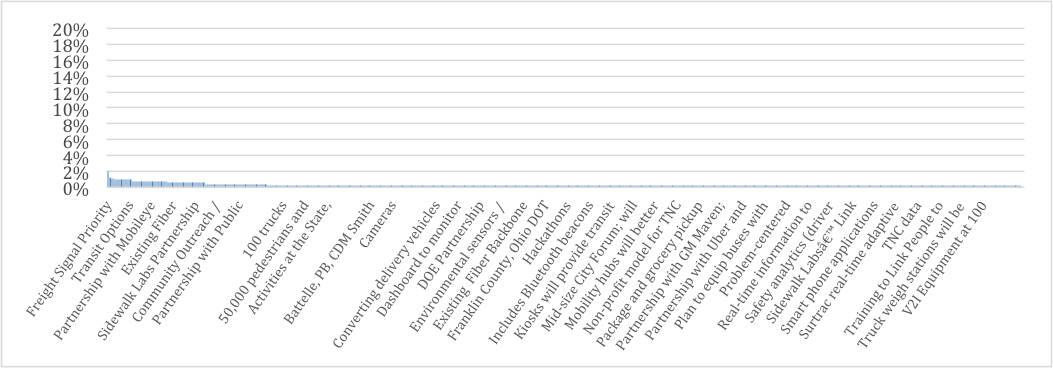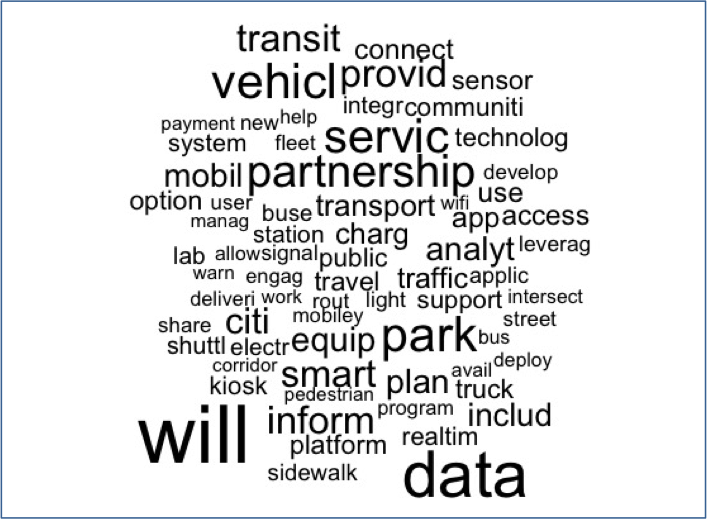A textual analysis of Smart City grant applications highlights data challenges for decision makers.
Throughout the year, there are many events focused on discussing different aspects of the transportation industry. From tech-focused meetups like Transportation Techies to highly organized conferences such as the Transportation Research Board annual meeting, I hear the same question time and time again: what is the future of smart cities?
I also hear the same themes: electric vehicles and infrastructure, driverless cars and safety, shared mobility and land-use planning. These are all important issues, and to become “smart”, even the most advanced cities must overcome a host of challenges. Identifying the core of these challenges is critical to moving forward in a smart and sustainable way.
So, what is the biggest challenge for aspiring smart cities?
In short, data issues are the biggest challenge facing smart cities of today and tomorrow. By examining the USDOT Smart City Challenge Dataset, out of the 50 different challenges identified, the top two were data challenges:
- Limited data to monitor the transportation system, and;
- Limited tools to support data driven decision-making.
In addition to the $40 million competitive grant, the USDOT Smart Cities Challenge included public-private partnerships to help the winning applicant with funding and other support services. Another core principle of the Smart Cities Challenge is sharing the knowledge and lessons learned with everyone. DOT created a dataset which compiles attributes of the seven finalists’ applications. This dataset aggregates data about the finalist cities in one place (as opposed to seven separate analyses) and provides a great deal of insight.
Rather than honing in on traditional, numerical transportation data such as project costs, travel time savings, and accidents avoided, this data set contains a different source of information: context. The narratives in the applications contain rich detail about the problems cities are trying to overcome today in order to be the smart cities of tomorrow. The words and phrases used in the applications can be quantified using textual analysis to better understand the roadblocks cities are facing today. (Spoiler alert: it isn’t driverless car technology.)
I examined text responses for two sections of the dataset: description and challenges. The description section contained 538 different descriptive phrases used across seven cities’ applications. At first I attempted to analyze the frequency distributions, but there were so many different responses, they did not even fit on one plot. A much less scientific – though much quicker – next step was making a Wordcloud of the most-used terms.
Distribution of Smart City Challenge Project Descriptions

Wordcloud of Smart City Challenge Finalists Project Proposals

Source: USDOT Smart City Challenge Finalists Project Proposals
Now we can see key trends and themes come to light. When I looked at the challenges section, which listed perceived challenges to Smart City projects, a more concrete picture emerged. While the most popular response was N/A*, controlling for the strategy responses corresponding to N/A in conjunction with other responses, a clear pattern emerged. The top ten challenges identified are presented below, and they represent 60 percent of all the challenges the applicants identified.
Top 10 Smart Cities Challenges as a Percent of All Responses
| Rank |
Challenge |
As a Percent of all Responses |
| 1 |
Limited Data to Monitor the Transportation System |
11.4% |
| 2 |
Limited Tools to Support Data Driven Decision Making |
10.4% |
| 3 |
Lack of Travel Options |
7.3% |
| 4 |
Freight Delays / Congestion |
5.5% |
| 5 |
Lack of Traveler Information |
5.2% |
| 6 |
Education and Adoption of EVs |
5.0% |
| 7 |
Complexity of Planning / Completing a Trip |
4.0% |
| 8 |
Digital Barriers |
3.8% |
| 10 |
Interoperability, Privacy, and Security |
3.7% |
| 10 |
Poor Air Quality / Harmful Vehicle Emissions |
3.7% |
Source: USDOT Smart City Challenge Finalists Project Proposals
Ignoring thorough narratives in grant applications such as the USDOT Smart Cities Challenge is to look past valuable context that can help cities better reflect on their own challenges and plan for the future.
Looking at the chart above, it becomes clear that many cities are not focused on technology alone when they develop a vision for how they can become a “smart” city. Instead, they look at how technology can be leveraged to gather and analyze data that will help them make informed decisions for the benefit of their residents.
By using this type of approach – blending conventional and nonconventional data sources and analysis – policymakers can cut through the noise in order to more easily identify the challenges cities face when delivering smart projects and services.
*This is the reason “partnership” is prevalent in the Wordcloud, and not the table. A separate analysis is in progress.
The views expressed above are those of the author and do not necessarily reflect the views of the Eno Center for Transportation.





